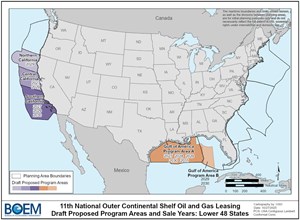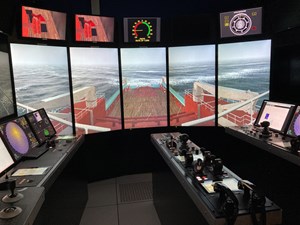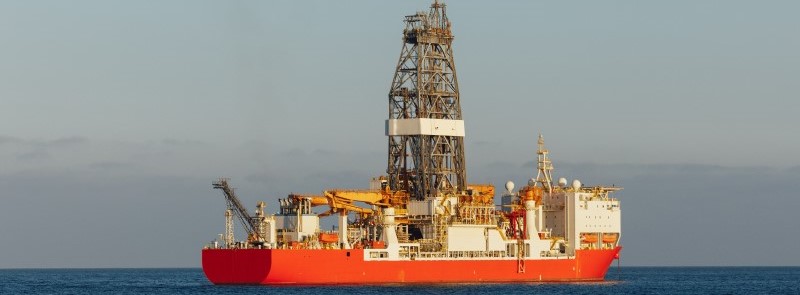KURT S. ABRAHAM, EDITOR-IN-CHIEF & CHIEF FORECASTER
Among the policy initiatives that the Trump administration has promised to make good on since taking office has been to rejuvenate offshore oil and gas leasing. Indeed, we’ve heard various comments out of the U.S. Department of the Interior (DOI) over the last six to eight months that a complete overhaul of federal offshore leasing coming soon, with a new, draft five-year plan.

Fig. 1. DOI’s proposed leasing program includes 21 areas off the coast of Alaska. Map: DOI.
Well, finally, the waiting is over. On Nov. 20, DOI announced the new offshore strategy, and it is significant. DOI has composed a Secretary’s Order titled “Unleashing American Offshore Energy,” directing the Bureau of Ocean Energy Management (BOEM) to take the necessary steps, in accordance with federal law, to terminate the restrictive Biden 2024–2029 National Outer Continental Shelf Oil and Gas Leasing Program and replace it with a new, expansive 11th National Outer Continental Shelf Oil and Gas Leasing Program by October 2026. As part of this directive, DOI is releasing the Secretary’s Draft Proposed Program for the 11th National Outer Continental Shelf Oil and Gas Leasing Program.
These actions certainly reflect the Trump administration’s continued commitment to restoring America’s offshore upstream activity by replacing the smallest offshore leasing plan ever published by an administration (Biden) with one that fully addresses the nation’s growing energy needs.

Fig. 2. DOI’s proposed leasing program includes seven in the Gulf of America and six along the Pacific coast. Map: DOI.
Under the new proposal for the 2026–2031 National Outer Continental Shelf Oil and Gas Leasing Program, DOI is taking a major step to boost U.S. energy independence and sustain domestic oil and gas production. The proposal includes as many as 34 potential offshore lease sales across 21 of 27 existing OCS planning areas, covering approximately 1.27 billion acres. That includes 21 areas off the coast of Alaska (Fig. 1), seven in the Gulf of America (Fig. 2), and six along the Pacific coast, Fig. 2. The proposal also includes the Interior Secretary Doug Burgum’s decision to create a new administrative planning area, the South-Central Gulf of America.
“Offshore oil and gas production does not happen overnight. It takes years of planning, investment, and hard work before barrels reach the market,” said Secretary Burgum. “The Biden administration slammed the brakes on offshore oil and gas leasing and crippled the long-term pipeline of America’s offshore production. By moving forward with the development of a robust, forward-thinking leasing plan, we are ensuring that America’s offshore industry stays strong, our workers stay employed, and our nation remains energy dominant for decades to come.”
Not surprisingly, reaction from the industry has been robust and enthusiastic. API President and CEO Mike Sommers called the proposal “a historic step toward unleashing our nation’s vast offshore resources,” praising DOI leadership for restarting a predictable leasing process after years of delay. NOIA President Erik Milito said the region—now formally designated “GOA Program Area A”—remains “the gold standard for offshore energy.” And IPAA President and CEO Edith Naegele said a robust five-year schedule is “essential to national security needs,” noting that including all OCS regions in early drafts enables competitive bidding and maximizes returns to the U.S. Treasury.
Gruesome Newsom. The fact that the new DOI/BOEM leasing plan calls for six lease sales off California’s coast between 2027 and 2030 certainly got the attention of the state’s governor, Gavin Newsom. After all, the U.S. has not auctioned drilling rights for any blocks in the Pacific Ocean since 1984. The news left Governor Goodhair squealing like a pig. “Trump’s idiotic plan endangers our coastal economy and communities and hurts the well-being of Californians,” said Newsom in a statement. “This reckless attempt to sell out our coastline to his Big Oil donors is dead in the water.”
Regardless of Newsom, DOI’s new plan is well-thought and gutsy. It takes some bold steps toward rebuilding U.S. offshore activity. And this editor is pleased to see that the DOI plan includes a lease sale in 2030 for the “High Arctic” area offshore Alaska’s north coast. Given the continued E&P activity in the Arctic by Russia and Norway, this is an important, needed move.
Texas Alliance fosters discussion of industry issues during annual meeting. Earlier this month, the Texas Alliance of Energy Producers held its annual meeting in Fort Worth, Texas, which was chock full of information shared in various sessions. In addition to an impressive roster of speakers on a variety of topics, yours truly was invited to present on the state of U.S. E&P, particularly onshore.
The first, partial day on Nov. 10 included a reception that featured an engaging panel of three association heads from key states for independent producers. The panel included Ron Ness, President, North Dakota Petroleum Council; Ed Cross, CEO, Illinois Oil and Gas Association; and Brook Simmons, President, Petroleum Alliance of Oklahoma. They provided some good “intelligence” in terms of what producers’ concerns are in these states and the special issues that they have to deal with.

Fig. 3. Yours truly engaged in a robust question-and-answer period with some members of the Texas Alliance of Energy Producers. Image: Texas Alliance of Energy Producers.
On the morning of Nov. 11, the breakfast session featured an interesting talk on the insurance market and perils for operators by Mark Wendell, Vice President, Underwriting, and Oil & Gas Program Manager, at BITCO Insurance Companies. Not surprisingly, affordable insurance, both in the field and in the office, continues to be a challenge for producers. David Prescott, President, Talon LPE, and author, updated the crowd on the progress being made by the industry with regard to environmental drilling, field services and consulting, as well as spill response/control. Rounding out the breakfast session was Texas Railroad Commission Chairman Jim Wright, who endeavored to explain a number of recent RRC decisions, actions and projects. One of the thornier subjects was a federally mandated plugging program that some operators contend is compelling the RRC to force some producers to plug wells that are merely inactive and not abandoned. This particular issue remains a work in progress, said Wright.
In the main morning session that followed, yours truly provided a look at current indicators mixed with elements of our summer drilling forecast and other factors to project where U.S. activity may head in early 2026. And there was some robust Q&A at the end, Fig. 3. The session also featured Kunal Patel, Senior Business Economist at the Federal Reserve Bank of Dallas, who is also the co-author of the Dallas Fed’s quarterly Energy Survey. Attendees were eager to hear his analysis of the current E&P market and what the Fed might do in response. Finally, the session included Linnea Lueken, Research Fellow with the Arthur B. Robinson Center on Climate and Environmental Policy at The Heartland Institute.
She put on an excellent talk that pointed out, to the delight of the audience, climate change myths and facts.

Fig. 4. At the Maersk Training facility in north Houston, one simulator duplicates the driller’s cabin and simulates an entire drilling floor on an offshore rig. Image: The author.
In the final morning session, Texas state Senator Tan Parker and Congressman Craig Goldman gave their respective assessments on the state and federal levels of where the political/regulatory situation affecting E&P is headed. With Nov. 11 being the traditional Veterans Day, the Alliance staged a 20-minute celebration that included military pomp, music and comments. The annual meeting finished up with a luncheon that featured newly minted IPAA President and CEO Edith Naegele in her first appearance before the Alliance membership. She delivered her vision for where she wants IPAA to head in its mission and the functions it should fulfill. Alliance President Karr Ingham and his staff should be congratulated on hosting a quality event for the association’s members.
Mixing training with simulation. Back in late October, Weatherford and Maersk Training announced a strategic partnership to advance managed pressure drilling (MPD) training, offering the industry’s first all-level IADC-accredited programs. The initiative will expand access to specialized MPD training, covering all levels of expertise from introductory to supervisory, while also enabling operators to unlock greater value from managed pressure wells. The latter is a holistic strategy that extends pressure management principles across the entire well lifecycle, from drilling to cementing, completions, and wireline operations. Through this partnership, Maersk Training and Weatherford are positioned to become the first companies globally with access to all levels of IADC MPD training.

Fig. 5. At the Maersk Training facility in north Houston, a simulator duplicates the entire bridge of an ocean-going ship, in this case, an offshore supply vessel. Image: The author.
In conjunction with this partnership and its activities, Maersk Training invited members of the media to attend an exclusive presentation and guided tour of its advanced training center, which is near Houston’s George Bush Intercontinental Airport. Yours truly was among the attendees of this event that provided an inside look at how Maersk delivers comprehensive, hands-on instruction across critical disciplines. These include safety, drilling (I particularly liked the simulator for an entire drilling floor, Fig. 4), maritime operations, crane handling, and open-water navigation (there was a simulated ship’s bridge with all the relevant controls and views present, Fig. 5). Attendees saw firsthand the use of sophisticated simulators, real-world equipment, and scenario-based drills that ensure training directly translates to on-the-job performance.
The visit also featured an overview of Maersk’s flexible training capabilities and the measurable results that can be achieved through its managed services programs for corporate clients. It was a very enlightening event, and the size of Maersk’s operation near the airport is deceivingly large.
IN THIS ISSUE
Special focus: Advances in Production. In this lead section, we have five articles on various topics related to this month’s theme. In one feature, Tracerco authors examine the efficiency in surfactant huff and puff. They describe how field trials provide new insights into fluid movement, recovery and EOR performance. In a second piece, several authors from Lifting Solutions discuss how a tapered PC pump for gassy applications can enhance pump efficiency and run life through improved gas handling. A third feature from Greene Tweed describes how engineered components are the difference between survival and failure in HPHT subsea systems. In our fourth article, experts from Spartan Controls and Emerson explain how a minor instrument upgrade led to major oil separator savings. Finally, NOV SMEs discuss how real-time, digital ESP management solutions help unlock new levels of efficiency across a well’s production life cycle.
Water management: Improving produced water management with electromagnetic flowmeters. An expert from KROHNE Group says the industry is increasingly adopting electromagnetic flowmeters (magmeters) to improve produced water management. With superior accuracy, reliability and smarter diagnostics than mechanical meters, magmeters are helping operators handle rising water volumes and regulatory
Deepwater/subsea technology. We have considerable material in this category, comprising three articles. In the first, SMEs from Siemens Energy and Advanced Mechatronics explain the enabling of low-cost subsea tie-ins with electrical high-integrity pressure protection systems (eHIPPS). In the second feature, two Superior Energy Services authors describe how a multi-zone single-trip (MST™) system overcame an extended sand plugging challenge in the deepwater Gulf of America/Mexico. In the final feature, an expert from Unique Group says that in the future, the need for reliable, compact and compliant human support systems will only grow. As offshore industries transition into deeper waters, the importance of safety-focused engineering becomes even more paramount.
Related Articles
FROM THE ARCHIVE

